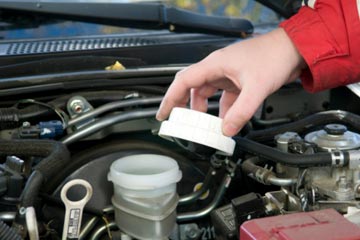
iStockphoto/Thinkstock
Never fill the reservoir above the "full" mark as this could cause damage to your brake system or cause it to overflow.
Remember the old "Flintstones" cartoon where Fred Flintstone would push his feet down to the ground to stop his car? Our car brakes today are surprisingly similar: We put our feet down, and the car stops. In our case, though, there are a couple things between us and the road -- tires, brakes and an amazingly useful and underappreciated liquid we call "brake fluid."
Without brake fluid, there's no way for the pressure you apply with your feet to make it to the brakes. It's like Fred reaching down with his feet, but not quite being able to reach the roadway -- not a good feeling when you're heading down a winding hill.
Because liquids are by nature relatively uncompressible (that is, applying pressure to a liquid doesn't appreciably decrease its volume), it makes an ideal medium to transfer pressure from your foot to the brake without losing force. An advantage of brake fluid over a strictly nonliquid mechanical option is that the driver doesn't feel the strong forces at work on the brake pads, where temperatures can soar to around 800 degrees Fahrenheit (426.7 degrees Celsius).
If you look at a 19th century stagecoach, you'll see a big lever on one side -- this is what they pulled to stop the carriage. Just imagine the vibrations shooting up your arm, especially if you needed to stop quickly.
Up Next |
As useful as brake fluid is, it still requires regular maintenance, just like your other automotive fluids such as coolant or motor oil. For most vehicles, it's recommended to change your brake fluid every 1 to 2 years. The owner's manual will have specific information for your vehicle.
If you're ambitious, you can change your own brake fluid. This process is not as straightforward as changing your motor oil, especially given the cramped conditions under the hood of today's vehicles. First you need to bleed, or drain, your brake fluid system, then add new, clean fluid. If you're up for the task of changing your own brake fluid, you can save a bundle. According to AutoMD, doing it yourself can save around $100 for the average vehicle [source: AutoMD]. Just realize that doing it wrong can cost you a lot more than that if your brakes give out.
Checking your fluid is quite a bit easier. We'll explain that in the next section.
Advertisement
